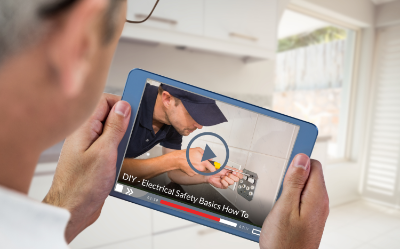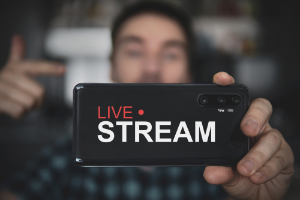Frequently asked questions on Streaming Video
With more than 500 webcasts realized in my life, I understand the importance of having the right information and resources to ensure a successful webcast. From the technical setup and streaming platform to the content and audience engagement, there is a lot to consider when planning a webcast.
Streaming video is a technology that allows users to watch digital video content, such as movies and television shows, on their computers, phones, tablets, and other devices without having to download it. Instead, the video content is delivered in small packets over the internet and is played back as it is being received, which allows users to watch the video in real time.
 The term “streaming” was originally used to describe the process of delivering audio content over the internet. However, it has since come to encompass any kind of live or on-demand video content, as well as audio content.
The term “streaming” was originally used to describe the process of delivering audio content over the internet. However, it has since come to encompass any kind of live or on-demand video content, as well as audio content.
Streaming video has become increasingly popular in recent years as more people have become comfortable using the internet and have access to faster connections. Services like Netflix, Hulu, YouTube, and other streaming services have made it possible for anyone to watch video content without having to download it or wait for it to be delivered over the mail.
The advantages of streaming video include being able to watch content on any device, anytime, anywhere, and being able to pause and rewind or fast-forward the video. Streaming video is also usually cheaper than buying or renting a DVD, and it eliminates the need for physical media, like discs or tapes.
The downside of streaming video is that it can be difficult to find content you want to watch, and streaming video can use up a lot of data if you’re not careful. Additionally, streaming video can be slow or choppy at times, depending on the speed of your internet connection.
Overall, streaming video is a great way to watch your favorite shows and movies anytime, anywhere. It’s becoming increasingly popular as more people become comfortable with using the internet, and as technology advances, so does the quality of streaming video.
 The term “streaming” was originally used to describe the process of delivering audio content over the internet. However, it has since come to encompass any kind of live or on-demand video content, as well as audio content.
The term “streaming” was originally used to describe the process of delivering audio content over the internet. However, it has since come to encompass any kind of live or on-demand video content, as well as audio content.
Streaming video has become increasingly popular in recent years as more people have become comfortable using the internet and have access to faster connections. Services like Netflix, Hulu, YouTube, and other streaming services have made it possible for anyone to watch video content without having to download it or wait for it to be delivered over the mail.
The advantages of streaming video include being able to watch content on any device, anytime, anywhere, and being able to pause and rewind or fast-forward the video. Streaming video is also usually cheaper than buying or renting a DVD, and it eliminates the need for physical media, like discs or tapes.
The downside of streaming video is that it can be difficult to find content you want to watch, and streaming video can use up a lot of data if you’re not careful. Additionally, streaming video can be slow or choppy at times, depending on the speed of your internet connection.
Overall, streaming video is a great way to watch your favorite shows and movies anytime, anywhere. It’s becoming increasingly popular as more people become comfortable with using the internet, and as technology advances, so does the quality of streaming video.
The answer is simple: almost any type of video you can think of is available for streaming. Whether you’re into movies, TV shows, sports, or educational videos, you’ll find something to watch on most streaming services.
 Let’s take a look at the different types of videos you can stream:
Let’s take a look at the different types of videos you can stream:
Movies: The most popular type of video to stream is movies. Whether you’re into classic films or modern blockbusters, you can find a huge selection to watch on streaming services.
TV Shows: Another popular type of video to stream is TV shows. From sitcoms to dramas, you’ll find your favorite TV shows available for streaming on most services.
Sports: Sports fans can also find plenty of streaming options. From professional sports leagues to college events, you can stream the games you’re most interested in.
Educational Videos: If you’re looking to learn something new, there are plenty of educational videos available for streaming. From courses on computer programming to science lectures, you’ll find plenty of videos to help you expand your knowledge.
Documentaries: Documentaries are also available for streaming. You can watch documentaries about current events, history, and more.
Viral Videos: Thanks to the internet, viral videos have become one of the most popular types of videos to stream. From funny clips to weird animal videos, you can find plenty of interesting viral videos to watch.
Short Films: Short films are another great type of video to stream. Whether you’re looking for something serious or lighthearted, there are plenty of short films available for streaming.
These are just some of the types of videos you can stream. From movies to educational videos, you’ll find something to watch on most streaming services. So if you’re looking for something to watch, be sure to check out all the options available for streaming.
 Let’s take a look at the different types of videos you can stream:
Let’s take a look at the different types of videos you can stream:
Movies: The most popular type of video to stream is movies. Whether you’re into classic films or modern blockbusters, you can find a huge selection to watch on streaming services.
TV Shows: Another popular type of video to stream is TV shows. From sitcoms to dramas, you’ll find your favorite TV shows available for streaming on most services.
Sports: Sports fans can also find plenty of streaming options. From professional sports leagues to college events, you can stream the games you’re most interested in.
Educational Videos: If you’re looking to learn something new, there are plenty of educational videos available for streaming. From courses on computer programming to science lectures, you’ll find plenty of videos to help you expand your knowledge.
Documentaries: Documentaries are also available for streaming. You can watch documentaries about current events, history, and more.
Viral Videos: Thanks to the internet, viral videos have become one of the most popular types of videos to stream. From funny clips to weird animal videos, you can find plenty of interesting viral videos to watch.
Short Films: Short films are another great type of video to stream. Whether you’re looking for something serious or lighthearted, there are plenty of short films available for streaming.
These are just some of the types of videos you can stream. From movies to educational videos, you’ll find something to watch on most streaming services. So if you’re looking for something to watch, be sure to check out all the options available for streaming.
Streaming videos online has become increasingly popular in recent years, and with good reason. Not only is it convenient, but it’s also cost-efficient and requires little technical know-how. But if you’re looking to get started streaming, you might be wondering, “What devices can I use to stream videos?”
A great place to start is with your computer or laptop. Most computers already have built-in webcams and microphones, so all you’ll need is a reliable internet connection. If you’re looking for a higher quality streaming experience, you might want to consider investing in a dedicated webcam and microphone.
 In addition to computers, you can also stream videos on other devices like smartphones and tablets. These devices are typically equipped with front-facing cameras and microphones, so you’ll be able to capture HD quality footage. You can also use a streaming app like YouTube or Twitch to stream videos from your device.
In addition to computers, you can also stream videos on other devices like smartphones and tablets. These devices are typically equipped with front-facing cameras and microphones, so you’ll be able to capture HD quality footage. You can also use a streaming app like YouTube or Twitch to stream videos from your device.
If you’re looking for more professional streaming equipment, you can invest in standalone devices like cameras, microphones, and lights. Professional-grade cameras like DSLRs and mirrorless cameras come with a range of features and allow you to record high quality footage. Meanwhile, standalone microphones and lights can help you create a more professional looking stream.
Overall, there are plenty of options when it comes to streaming videos online. Whether you’re looking for something low-cost and easy to use or a more professional setup, you’ll be able to find the right device for your needs. By investing in the right equipment, you’ll be able to take your streaming experience to the next level.
A great place to start is with your computer or laptop. Most computers already have built-in webcams and microphones, so all you’ll need is a reliable internet connection. If you’re looking for a higher quality streaming experience, you might want to consider investing in a dedicated webcam and microphone.
 In addition to computers, you can also stream videos on other devices like smartphones and tablets. These devices are typically equipped with front-facing cameras and microphones, so you’ll be able to capture HD quality footage. You can also use a streaming app like YouTube or Twitch to stream videos from your device.
In addition to computers, you can also stream videos on other devices like smartphones and tablets. These devices are typically equipped with front-facing cameras and microphones, so you’ll be able to capture HD quality footage. You can also use a streaming app like YouTube or Twitch to stream videos from your device.
If you’re looking for more professional streaming equipment, you can invest in standalone devices like cameras, microphones, and lights. Professional-grade cameras like DSLRs and mirrorless cameras come with a range of features and allow you to record high quality footage. Meanwhile, standalone microphones and lights can help you create a more professional looking stream.
Overall, there are plenty of options when it comes to streaming videos online. Whether you’re looking for something low-cost and easy to use or a more professional setup, you’ll be able to find the right device for your needs. By investing in the right equipment, you’ll be able to take your streaming experience to the next level.
 Are you interested in getting started with streaming video? Streaming video has become increasingly popular in recent years, and it can be a great way to engage with your audience and share your content with them. But before you get started with streaming video, there are a few things you’ll need to consider.
Are you interested in getting started with streaming video? Streaming video has become increasingly popular in recent years, and it can be a great way to engage with your audience and share your content with them. But before you get started with streaming video, there are a few things you’ll need to consider.
First, you’ll need to invest in the right equipment. You’ll need a camera, a microphone, and a light. If you’re just starting out, you don’t need to break the bank on expensive equipment. You can get started with a decent quality camera and microphone, and a basic light set up. If you’re looking to step up your streaming game, you can invest in higher quality equipment.
Next, you’ll need to decide where you’ll be streaming your video. There are a variety of streaming platforms, including YouTube, Twitch, Facebook, and more. Each platform has its own unique features and benefits, so you’ll want to decide which platform is the best fit for your content.
Once you’ve decided which platform you’ll be streaming on, you’ll want to create an account and set up your streaming page. This includes adding a profile picture, a description of what you’ll be streaming, and other information about your stream.
Finally, you’ll need to decide how you’ll be streaming. You can stream video live or pre-record and upload it to your streaming platform. Live streaming is great for connecting with your audience in real time, while pre-recording allows you to edit the video and add additional elements.
Now that you have the basics down, you’re ready to start streaming! Have fun and engage with your audience, and you’ll be streaming in no time. Good luck!
When it comes to streaming videos, one of the most frequent questions is: “How much does it cost?” The cost of streaming videos is dependent on many factors, such as the equipment needed (camera, microphone, light, etc.), the hosting and streaming services, and the bandwidth needed to stream videos.
 The cost of streaming videos starts with the equipment. If you want to stream videos, you’ll need a camera, microphone, and light. This can range from a few hundred dollars to thousands of dollars depending on the quality and features you’re looking for.
The cost of streaming videos starts with the equipment. If you want to stream videos, you’ll need a camera, microphone, and light. This can range from a few hundred dollars to thousands of dollars depending on the quality and features you’re looking for.
Next, you’ll need a hosting and streaming service. This is where you store your videos and where they can be accessed by viewers. Popular services such as YouTube, Vimeo, and Wistia offer all the features you need to host and stream videos. Costs vary depending on the provider, but typically range from $5 to $50 per month.
Finally, you’ll need to consider the bandwidth needed to stream videos. This varies greatly depending on the size of your videos and the number of viewers. If you’re streaming videos to a large number of people, you may need to use a Content Delivery Network (CDN). CDNs are paid services, with fees ranging from a few cents to several dollars per video.
In addition to the above costs, you may also need to consider a website to host your videos. If you’re using a hosting and streaming service, you may be able to stream your videos directly from their site. But if you want to build a website for your videos, you’ll need to pay for web hosting and a domain name, which can range from a few dollars to several hundred dollars per year.
So, to answer the question of “How much does it cost to stream videos?” the answer is that it depends. The cost of streaming videos is dependent on the equipment and services you use, as well as the bandwidth needed to stream your videos. However, with the right equipment and services, streaming videos can be surprisingly affordable.
 The cost of streaming videos starts with the equipment. If you want to stream videos, you’ll need a camera, microphone, and light. This can range from a few hundred dollars to thousands of dollars depending on the quality and features you’re looking for.
The cost of streaming videos starts with the equipment. If you want to stream videos, you’ll need a camera, microphone, and light. This can range from a few hundred dollars to thousands of dollars depending on the quality and features you’re looking for.
Next, you’ll need a hosting and streaming service. This is where you store your videos and where they can be accessed by viewers. Popular services such as YouTube, Vimeo, and Wistia offer all the features you need to host and stream videos. Costs vary depending on the provider, but typically range from $5 to $50 per month.
Finally, you’ll need to consider the bandwidth needed to stream videos. This varies greatly depending on the size of your videos and the number of viewers. If you’re streaming videos to a large number of people, you may need to use a Content Delivery Network (CDN). CDNs are paid services, with fees ranging from a few cents to several dollars per video.
In addition to the above costs, you may also need to consider a website to host your videos. If you’re using a hosting and streaming service, you may be able to stream your videos directly from their site. But if you want to build a website for your videos, you’ll need to pay for web hosting and a domain name, which can range from a few dollars to several hundred dollars per year.
So, to answer the question of “How much does it cost to stream videos?” the answer is that it depends. The cost of streaming videos is dependent on the equipment and services you use, as well as the bandwidth needed to stream your videos. However, with the right equipment and services, streaming videos can be surprisingly affordable.
Are you considering streaming content but not sure what restrictions may be in place? Streaming content is becoming increasingly popular these days, and it’s important to know what restrictions may be in place to ensure your content is compliant and safe.
There are a few restrictions you need to be aware of when streaming content. One is that you cannot stream content that is copyright protected. This means you cannot stream any content that has been created by someone else and copyrighted, such as music or videos. This includes music from streaming services like Spotify and videos from streaming services like Netflix. Any content that has been created by someone else and copyrighted cannot be streamed without the express written consent of the copyright holder.
 In addition to copyright restrictions, you also need to be mindful of streaming content that may be considered offensive or harmful. This includes content that could be considered obscene, indecent, defamatory, or libelous, as well as any content which could incite hatred or violence against any group of people. Such content should be avoided at all costs and may lead to legal action if streamed.
In addition to copyright restrictions, you also need to be mindful of streaming content that may be considered offensive or harmful. This includes content that could be considered obscene, indecent, defamatory, or libelous, as well as any content which could incite hatred or violence against any group of people. Such content should be avoided at all costs and may lead to legal action if streamed.
Finally, it’s important to be aware of streaming content which may be considered inappropriate for certain age groups. This includes content which may not be suitable for children, such as violent or explicit material. Any content which may be considered inappropriate for certain age groups should be restricted or self-censored to ensure it is not streamed.
Overall, it’s important to remember that when streaming content, there are a number of restrictions in place that must be adhered to. These include copyright restrictions, restrictions on content which may be considered offensive or harmful, and restrictions on content which may be considered inappropriate for certain age groups. By ensuring you are aware of these restrictions before streaming content, you can ensure your content is compliant and safe.
There are a few restrictions you need to be aware of when streaming content. One is that you cannot stream content that is copyright protected. This means you cannot stream any content that has been created by someone else and copyrighted, such as music or videos. This includes music from streaming services like Spotify and videos from streaming services like Netflix. Any content that has been created by someone else and copyrighted cannot be streamed without the express written consent of the copyright holder.
 In addition to copyright restrictions, you also need to be mindful of streaming content that may be considered offensive or harmful. This includes content that could be considered obscene, indecent, defamatory, or libelous, as well as any content which could incite hatred or violence against any group of people. Such content should be avoided at all costs and may lead to legal action if streamed.
In addition to copyright restrictions, you also need to be mindful of streaming content that may be considered offensive or harmful. This includes content that could be considered obscene, indecent, defamatory, or libelous, as well as any content which could incite hatred or violence against any group of people. Such content should be avoided at all costs and may lead to legal action if streamed.
Finally, it’s important to be aware of streaming content which may be considered inappropriate for certain age groups. This includes content which may not be suitable for children, such as violent or explicit material. Any content which may be considered inappropriate for certain age groups should be restricted or self-censored to ensure it is not streamed.
Overall, it’s important to remember that when streaming content, there are a number of restrictions in place that must be adhered to. These include copyright restrictions, restrictions on content which may be considered offensive or harmful, and restrictions on content which may be considered inappropriate for certain age groups. By ensuring you are aware of these restrictions before streaming content, you can ensure your content is compliant and safe.
 Streaming videos is becoming increasingly popular, as more and more people are watching their favorite shows, movies, and other content online. But if you’re looking to stream videos, the quality of your internet connection is going to play a major role in the overall experience.
Streaming videos is becoming increasingly popular, as more and more people are watching their favorite shows, movies, and other content online. But if you’re looking to stream videos, the quality of your internet connection is going to play a major role in the overall experience.
In this part, we’ll take a look at what kind of internet connection you need to stream videos without any issues. We’ll also discuss some of the key factors that determine the quality of your internet connection and how to optimize it for streaming.
So, what kind of internet connection do you need to stream videos? The short answer is that you need a reliable broadband connection with a decent download speed. But to get a better picture of what you need, here are some of the key factors you should consider:
Download Speed: The download speed of your internet connection is probably the most important factor when it comes to streaming videos. Generally, the higher the download speed, the better the streaming experience will be. Most streaming services recommend a minimum download speed of around 5 Mbps for HD videos and 25 Mbps for 4K videos.
Upload Speed: While upload speed isn’t as important as download speed when streaming videos, it’s still a good idea to have an adequate upload speed. This will ensure that the video streams smoothly without any buffering or lagging issues. Most streaming services recommend a minimum upload speed of at least 1 Mbps.
Bandwidth: Bandwidth is another important factor when streaming videos. It’s important to have enough bandwidth available to accommodate multiple streams at the same time. Most streaming services recommend a minimum bandwidth of at least 5 Mbps.
Latency: Latency is a measure of how quickly your internet connection can respond to requests. It’s important to have a low latency if you want your video streams to start quickly. A latency of less than 100 milliseconds is recommended for streaming videos.
These are some of the key factors you should consider when determining what kind of internet connection you need to stream videos. If you’re looking to optimize your internet connection for streaming, here are some tips you can follow:
- Make sure that your internet connection is reliable and has a consistent download and upload speed.
- Use a wired connection if possible, as this will provide the best streaming experience.
- Make sure that your router is set up correctly, as this will ensure that your connection is optimized for streaming.
- Upgrade your internet plan if needed, as this will give you access to higher download and upload speeds.
- Make sure that your computer or device is connected to the internet using the most up-to-date software and settings.
 When it comes to streaming video, one of the most important factors is the quality of the playback. After all, no one wants to be stuck watching a grainy, pixelated video that’s barely watchable.
When it comes to streaming video, one of the most important factors is the quality of the playback. After all, no one wants to be stuck watching a grainy, pixelated video that’s barely watchable.
Unfortunately, video playback quality can vary widely depending on a number of factors, including the streaming platform, the type of device you’re using, the connection speed, and more. In this article, we’ll walk you through the different types of video playback quality you can expect so that you can get the most out of your streaming experience.
First, let’s talk about basic streaming quality. This is the type of quality you can expect when you’re streaming a movie or TV show from a service like Netflix or Hulu. Most streaming platforms will offer up to HD (high definition) streaming, which is usually represented by 720p or 1080p.
However, some services will offer 4K and even 8K streaming, depending on the type of device you’re using and the speed of your internet connection. Keep in mind that to get the best possible quality, you should be using a device that supports 4K and 8K streaming, and your internet connection should be at least 25 Mbps (megabits per second).
Next, let’s talk about live streaming quality. This is the type of quality you can expect when you’re streaming a live event, such as a sports game or a live concert. Most streaming services will offer up to HD streaming, but the quality can vary depending on the speed of your internet connection and the type of device you’re using.
For the best possible quality, you should be using a device that supports 4K and 8K streaming, and your internet connection should be at least 25 Mbps. Additionally, some streaming services may offer lower quality streaming for live events, such as 480p and 720p, for those with slower connections.
Finally, let’s talk about virtual reality (VR) streaming quality. This is the type of quality you can expect when you’re streaming a VR experience, such as a game or a movie. Most streaming services will offer up to HD streaming, but the quality can vary depending on the speed of your internet connection and the type of device you’re using.
For the best possible quality, you should be using a device that supports 4K and 8K streaming, and your internet connection should be at least 25 Mbps. Additionally, some streaming services may offer lower quality streaming for VR experiences, such as 480p and 720p, for those with slower connections.
Overall, the type of quality you can expect when streaming video depends on a number of factors, such as the streaming platform, the type of device you’re using, the speed of your internet connection, and more. To get the best possible quality, you should always be using a device that supports 4K and 8K streaming, and your internet connection should be at least 25 Mbps.
By understanding the different types of video playback quality that are available, you can make sure you’re getting the most out of your streaming experience.
 Video streaming is becoming increasingly popular in the corporate world and is quickly becoming an integral part of the way companies do business. But what are the benefits of streaming videos for a company?
Video streaming is becoming increasingly popular in the corporate world and is quickly becoming an integral part of the way companies do business. But what are the benefits of streaming videos for a company?
1. Cost-Effective: Streaming videos is far more cost-effective than traditional video production. With streaming videos, you don't need to hire a production team, invest in expensive video equipment or invest in costly physical media. This can be a huge cost saving for companies.
2. Increased Reach: Streaming videos can be viewed from anywhere with an internet connection, meaning your audience has no geographical limits. This makes it easier to reach a larger audience, helping to increase your company's visibility and reach.
3. Higher Engagement: Streaming videos can be interactive and engaging, making it easier to capture the attention of your audience and keep them engaged for longer. This encourages more interaction with your brand and can lead to higher levels of customer loyalty and engagement.
4. Real-Time Updates: Streaming videos enables companies to quickly and easily update their content as needed without having to go through expensive and time consuming production processes. This makes it easier to keep up with the latest trends and changes in the industry, making sure your company is always one step ahead.
5. Increased Brand Awareness: Streaming videos can help to increase brand awareness by making your company’s content more accessible and visible. This helps to create a sense of familiarity among your target audience, leading to higher brand recognition.
Overall, streaming videos offer a wide range of benefits for companies. Not only are they cost-effective, but they also help to increase reach, engagement and brand awareness. As such, streaming videos are a great way for companies to keep up with the latest trends, stay ahead of the competition and engage with their audience more effectively.
 Are you a content producer looking for a free streaming video service? If so, you're in luck! With the rise of digital media consumption, there are now a number of free streaming video services available for producers to use. From YouTube to Vimeo, here are some of the top free streaming video services available for producers.
Are you a content producer looking for a free streaming video service? If so, you're in luck! With the rise of digital media consumption, there are now a number of free streaming video services available for producers to use. From YouTube to Vimeo, here are some of the top free streaming video services available for producers.
YouTube
YouTube is one of the most popular free streaming video services available for producers. With over 2 billion monthly active users, YouTube offers a huge audience for content creators. Its massive user base and wide range of content gives producers the opportunity to reach a diverse range of viewers. YouTube also offers a variety of features such as live streaming capabilities, channel customization, and analytics that make it an attractive option for content producers.
Vimeo
Vimeo is a popular free streaming video service that is often used by independent filmmakers and video producers. It is known for its high-quality video streaming capabilities, which make it an ideal choice for producers who want to showcase their work. Vimeo also offers features such as embedding, customization, and analytics, making it an attractive option for content producers.
DailyMotion
DailyMotion is a free streaming video service that is quickly becoming popular among content producers. It offers high-definition streaming and a wide range of content that producers can choose from. It also has a variety of features including embedding, customization, and analytics.
Twitch
Twitch is an online streaming platform that is popular among gamers and content producers. It offers an array of features, such as live streaming capabilities, analytics, and the ability to host live chats with viewers. Twitch also offers a wide range of content and a large audience, making it an attractive option for content producers.
These are just some of the free streaming video services available for producers. With the rise of digital media consumption, there are now a variety of options available for content producers to take advantage of. Whether you're looking to reach a broad audience, stream high-quality video, or host live events, there is a streaming video service out there for you. So don't hesitate to explore the options and find the best streaming video service for your needs.
